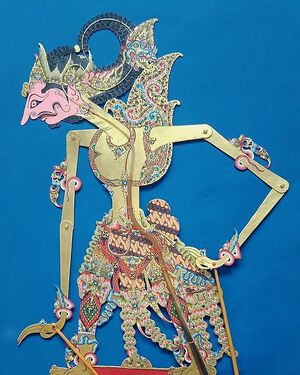Kencakarupa - (Wayang Kulit)
| Title | Kencakarupa - (Raden) - Mahabharata |
|---|---|
| Other names | Kecaka |
| Size | 50 cm |
| Personal data | Kencakarupa is the son of Palasara, from the Retawu hermitage, with Dewi Kekayi, the daughter of Prabu Kekaya from the Kencaka country, and is the twin brother of Rupakenca. Both are adopted sons of Prabu Palasara and Dewi Durgandini. It’s also said that Kencakarupa was created from a broken boat rudder hit by a large rock, which was used by Resi Palasara and Dewi Durgandini, daughter of Prabu Basukesti, king of the Wirata country, to cross the Ganges river. In another story, Kencakarupa is a human who was made from the ketir of Dewi Durgandini's boat. Katir or cadik is a boat balancing device that is usually installed crosswise from the right to the left of the boat. Kencakarupa came together with his other siblings, namely: Rajamala, Upakeca / Rupakenca, Setatama, Gendawana and Dewi Ni Yutisnawati / Rekatawati. Kencakarupa also has three other adopted siblings, namely: Bagawan Abiyasa, son of Resi Palasara with Dewi Durgandini, Citragada and Wicitrawirya, both sons of Dewi Durgandini with Prabu Santanu, king of the Astina country. |
| Appearance | Kencakarupa has a stubborn character, a traitor who wants to win on his own. He is brave, arrogant and always follows his own heart. He is very powerful and skilled in military skills using mace and javelin/spear weapons. Kencakarupa has three layers of bergaruda and waderan. Berpraba, berlangang, berpontoh and berroncong. Ring on ring finger. Raden Kencakarupa had kedondong eyes, a sembada nose, complete, mustache, godheg (sideburns), hair shaped like a lizard (like a climbing sack), in which case the hair was wound as tightly as possible, then wound around a long comb called a plengkung comb (a long curved comb) from the hair coils on the comb that is called a lizard. This way of dressing up was also used in the Surakarta area, when men still kept their hair long. |
| Collection | Private collection |
Kencakarupa – (Raden) – Mahabharata
The way of caring for hair for men was more difficult than for women, because men's buns were considered more important and had to be neater than women's buns. Every day men's hair had to be oiled in such a way that the oil came out, if the hair was squeezed. The base of the hair was tied as tightly as possible with a rope called a hair rope made of black thread. But this way of caring for hair was only for young people or old people who did not use headbands. Those who worked in the Kraton environment used to have to care for their hair in such a way. In fact, when entering the palace, your hair must be removed from its bun, which in Javanese is called ngore.
Kencakarupa is Wirata's mainstay senopati. This knight is a hero of the Wirata country. It is his nature to uphold himself and be proud of his supernatural powers.
The end of his story is told, Kencakarupa was killed in battle against Jagal Abilawa (Bima’s disguise), the second brother of Pendawa, because together with his brothers Rupakenca, Setatama and Gandawana rebelled to overthrow the power of the Wirata king, Prabu Matswapati.
The death of Raden Kencakarupa was felt by the Virata kingdom because it lost a hero who was revered by the entire population of Wirata. But according to history, the knight was naturally weak in war, due to his arrogance. In fact, inwardly the Virata people felt grateful that Kencakarupa died, because in their opinion his behavior would only lower the status of the Virata state. This power and courage will not be beneficial, on the contrary it will actually be detrimental to the country.
But by the will of nature, Kencakarupa's magic was subdued by Raden Bratasena's prowess. So the defeat of the Virata hero did not harm the country and actually upheld the dignity of the Virata state.
Source: History of Wayang Purwa - Hardjowirogo - PN Balai Pustaka – 1982
Blog: Hadisukirno – Yogyakarta – 2012


